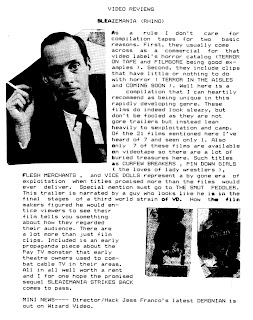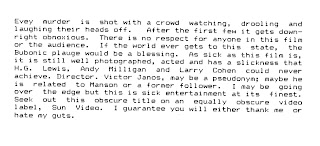Search This Blog
Saturday, May 28, 2016
HI-TECH TERROR #3
This issue of HI-TECH TERROR leads off with paranoia in Hollywood about the VCR. They had designed an anti-copying signal that was supposed to save them from ruination. Talk about an industry full of "chicken littles"! Of course the VCR ended up saving their sorry asses. Technology is a two way street of course. You create something to defeat copying, and someone else will create a little black box that will defeat the anti-copying signal. In a preview of the future direction this zine would take, I review ZOMBIE LAKE. I hated it, and I still do! Enjoy HTT #3!
Thursday, May 19, 2016
HI-TECH TERROR #2
With the second issue of HTT I decided to add some graphics to try and make it halfway presentable. Kind of like putting lipstick on a pig. One of the stupidest things I did was to split the text with a picture on the first page. hard as Hell to read! Funny reading about VHS vs Beta, A lot of VHS releases news, along with satellite TV and other ephemera. Wrapped up with a review of fellow Texan SF Brownrigg's KEEP MY GRAVE OPEN.
Sunday, May 15, 2016
HI-TECH TERROR #1
Years before I started the newsletter/magazine EUROPEAN TRASH CINEMA, I published a very cheesy newsletter called HI-TECH TERROR. At the time, it was the first newsletter devoted to trashy films on video only. Before that time, film review newsletters were devoted to theatrical releases only. I published 43 issues before it mutated into ETC. If there's interest, I will republish all of them on the blog. Many of fandom's best writers contributed reviews, so it's not just me rambling on. You will see near the end where my interest in US crap wanes and the European influence takes over. Ok, below is the very first one. To view a larger image, just right click on it, open link in new tab and you can then make it larger and easier to read.
Friday, May 6, 2016
COLD EYES OF FEAR by Dennis Capicik
COLD EYES OF FEAR
a.k.a. Gli Occhi Fredda della Paura
Italy/Spain, 1971.
D: Enzo G. Castellari
P: Mario Mariano & José Frade for Cinemar-Atlantida Films//St & Sc: Leo Anchóriz, Tito Carpi & Enzo G. Castellari//DP: Antonio L. Ballesteros//E: Vincenzo Tomassi//M: Ennio Morricone.
Cast: Giovanna Ralli, Frank Wolff, Fernando Rey, Julián Mateos, Karin Schubert, Gianni Garko, Leonardo Scavino, Franco Marletta.
Produced at the height of the giallo craze, Enzo G. Castellari (director Enio Girolami hiding behind his usual pseudonym) was commissioned by Spanish producer José Frade to helm this offbeat effort, which, despite its intriguing title and rather great cast, is pretty far removed from the usual conventions of the genre.
Beginning promisingly, a beautiful half-naked woman (Karin Schubert) is stalked by a man with a switchblade, but this all-too-familiar opening actually turns out to be part of a stage show at ‘The Carousel’, a trendy nightspot whose feature attraction happens to be “Ooh La La!” Outside of this Jess Franco-styled deceptive opening, the film quickly moves into reality as Peter (spaghetti western stalwart Gianni Garko), a rather naïve lawyer, successfully picks-up Anna (Giovanna Ralli), and after some incidental travelogue footage of London’s nightlife, takes her back to his uncle’s (Fernando Rey) house, who also happens to be a prominent judge. Upon their arrival, they encounter Quill (Julián Mateos), a mysterious stranger, who has already killed the butler, and then, a ‘bobby’ appears at the front door, but much to the astonishment of Peter and Anna, this ‘saviour’ turns out to be Arthur Welt (Frank Wolff), who is working in tandem with Quill. Through the course of this rather slow-moving film, it’s revealed that Welt is searching for some elusive documents, which would prove his “wrongful conviction” some fifteen years earlier and thus clear his name.
Quite obviously inspired by William Wyler’s DESPERATE HOURS (1955), with Humphrey Bogart – hence the film’s original English-language export title DESPERATE MOMENTS – Castellari’s film does manage to sustain some general interest thanks to the likable cast, who, through the progression of the film reveal their insecurities and vulnerabilities as Welt’s plan slowly withers away. Welt is frustrated at (quote) “getting the shaft,” and the prospect of spending still more time in jail. Welt’s partner Quill also quickly unravels once he realizes that, after getting lured into a potential robbery and only finding a lousy 50-quid in the house safe, he was actually duped by Welt to further HIS agenda. In fact, the entire cast revels in desperation (as in Wyler’s film) during their rather intense standoff as Peter also realizes that the world isn’t quite as ‘black-and-white’ as he may have thought; even Anna has no qualms about getting into the thick of it as she tries to turn Quill against Welt, and then, in a risky tactic proceeds to question his mettle when it doesn’t work out. A few years later, Giovanna Ralli would go on to portray the District Attorney in Massimo Dallamano’s superb WHAT HAVE THEY DONE TO YOUR DAUGHTERS? (1974), whose character therein was, yet again, another assertive and very confident woman who could hold her own in the usually male-dominated polizieschi.
The usually reliable Castellari doesn’t necessarily disappoint, but giallo thrillers were definitely not his strong point as opposed to westerns or its similar urban brethren, the polizieschi. Known for his rather hard-hitting spaghetti westerns like GO KILL THEM ALL AND COME BACK ALONE (1968) or polizieschi such as The BIG RACKET (1977), here Castellari doesn’t really dwell on slow-motion action scenes, which dominated much of his later work, but he still experiments with all sorts of stylish flourishes like experimental camera angles, staccato cutting, shot reversals and all sorts of weird montages like some low-rent Antonioni. Prolific composer Ennio Morricone also contributes a strange, almost experimental score, which definitely adds a layer of ‘psychedelia’ perfectly encapsulating the distorted states of the primary characters. Although, during Peter and Anna’s London excursion, Morricone provides a customary lounge track, so prevalent in most gialli of the time, which is yet another gem in the composer’s long and varied career.
Pretty much available since the dawn of the DVD, COLD EYES OF FEAR has been in print through most of Redemption’s partnerships with Image Entertainment, RYKO and Kino, who have also issued it on Blu-ray. It’s a beautiful transfer and worth checking out, but those expecting an honest-to-goodness giallo, will undoubtedly be disappointed.
a.k.a. Gli Occhi Fredda della Paura
Italy/Spain, 1971.
D: Enzo G. Castellari
P: Mario Mariano & José Frade for Cinemar-Atlantida Films//St & Sc: Leo Anchóriz, Tito Carpi & Enzo G. Castellari//DP: Antonio L. Ballesteros//E: Vincenzo Tomassi//M: Ennio Morricone.
Cast: Giovanna Ralli, Frank Wolff, Fernando Rey, Julián Mateos, Karin Schubert, Gianni Garko, Leonardo Scavino, Franco Marletta.
Produced at the height of the giallo craze, Enzo G. Castellari (director Enio Girolami hiding behind his usual pseudonym) was commissioned by Spanish producer José Frade to helm this offbeat effort, which, despite its intriguing title and rather great cast, is pretty far removed from the usual conventions of the genre.
Beginning promisingly, a beautiful half-naked woman (Karin Schubert) is stalked by a man with a switchblade, but this all-too-familiar opening actually turns out to be part of a stage show at ‘The Carousel’, a trendy nightspot whose feature attraction happens to be “Ooh La La!” Outside of this Jess Franco-styled deceptive opening, the film quickly moves into reality as Peter (spaghetti western stalwart Gianni Garko), a rather naïve lawyer, successfully picks-up Anna (Giovanna Ralli), and after some incidental travelogue footage of London’s nightlife, takes her back to his uncle’s (Fernando Rey) house, who also happens to be a prominent judge. Upon their arrival, they encounter Quill (Julián Mateos), a mysterious stranger, who has already killed the butler, and then, a ‘bobby’ appears at the front door, but much to the astonishment of Peter and Anna, this ‘saviour’ turns out to be Arthur Welt (Frank Wolff), who is working in tandem with Quill. Through the course of this rather slow-moving film, it’s revealed that Welt is searching for some elusive documents, which would prove his “wrongful conviction” some fifteen years earlier and thus clear his name.
Quite obviously inspired by William Wyler’s DESPERATE HOURS (1955), with Humphrey Bogart – hence the film’s original English-language export title DESPERATE MOMENTS – Castellari’s film does manage to sustain some general interest thanks to the likable cast, who, through the progression of the film reveal their insecurities and vulnerabilities as Welt’s plan slowly withers away. Welt is frustrated at (quote) “getting the shaft,” and the prospect of spending still more time in jail. Welt’s partner Quill also quickly unravels once he realizes that, after getting lured into a potential robbery and only finding a lousy 50-quid in the house safe, he was actually duped by Welt to further HIS agenda. In fact, the entire cast revels in desperation (as in Wyler’s film) during their rather intense standoff as Peter also realizes that the world isn’t quite as ‘black-and-white’ as he may have thought; even Anna has no qualms about getting into the thick of it as she tries to turn Quill against Welt, and then, in a risky tactic proceeds to question his mettle when it doesn’t work out. A few years later, Giovanna Ralli would go on to portray the District Attorney in Massimo Dallamano’s superb WHAT HAVE THEY DONE TO YOUR DAUGHTERS? (1974), whose character therein was, yet again, another assertive and very confident woman who could hold her own in the usually male-dominated polizieschi.
The usually reliable Castellari doesn’t necessarily disappoint, but giallo thrillers were definitely not his strong point as opposed to westerns or its similar urban brethren, the polizieschi. Known for his rather hard-hitting spaghetti westerns like GO KILL THEM ALL AND COME BACK ALONE (1968) or polizieschi such as The BIG RACKET (1977), here Castellari doesn’t really dwell on slow-motion action scenes, which dominated much of his later work, but he still experiments with all sorts of stylish flourishes like experimental camera angles, staccato cutting, shot reversals and all sorts of weird montages like some low-rent Antonioni. Prolific composer Ennio Morricone also contributes a strange, almost experimental score, which definitely adds a layer of ‘psychedelia’ perfectly encapsulating the distorted states of the primary characters. Although, during Peter and Anna’s London excursion, Morricone provides a customary lounge track, so prevalent in most gialli of the time, which is yet another gem in the composer’s long and varied career.
Pretty much available since the dawn of the DVD, COLD EYES OF FEAR has been in print through most of Redemption’s partnerships with Image Entertainment, RYKO and Kino, who have also issued it on Blu-ray. It’s a beautiful transfer and worth checking out, but those expecting an honest-to-goodness giallo, will undoubtedly be disappointed.
Subscribe to:
Comments (Atom)












